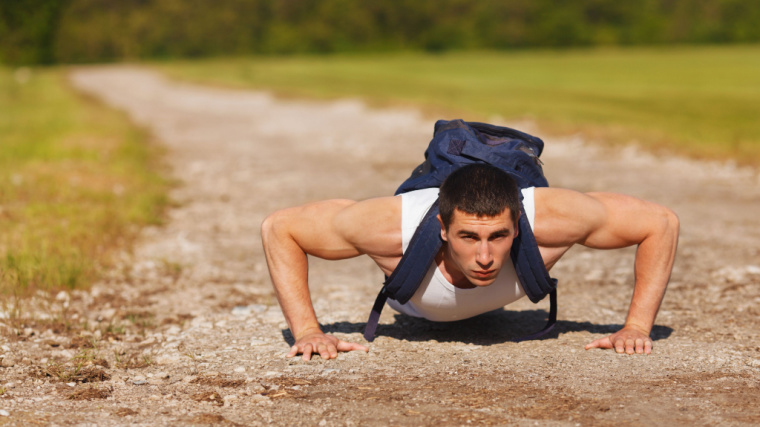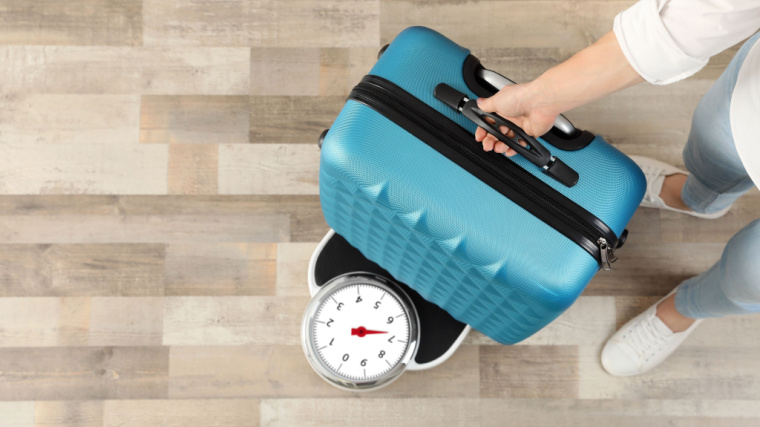The gym is way out there, and you’re not leaving your living room any time soon. Maybe you’re watching the kids, or maybe your car’s in the shop. Whatever the case may be, sometimes bodyweight-only workouts will cut it. And other times, you just need the sweet release of lifting something heavy.

If you don’t have weight plates at home, there’s no need to despair. You probably have all the fitness equipment you need already — it’s just disguised as household equipment. So when you need to lift heavy so badly that you’re about to carry your fully-grown German shepherd around in your arms just for a workout, start looking around the house differently. You’ll find these household items are also pretty good at being fitness equipment.
Household Items That Double as Fitness Equipment
Pot
If you’ve ever loaded a pot full to the brim with chili into the car for a family holiday gathering, then you know — pots aren’t just for cooking. They can get heavy pretty quickly. That’s not the best thing when you go to take something off the stove without oven mitts. But it’s great news for your at-home strength training.
Digging out your biggest pot from amongst all your pots and pans has a whole host of benefits for your “equipment”-free training. For one thing, you can customize the amount of weight you’re using. Adding a little bit of water to the pot makes it only moderately heavy, whereas adding a whole lot more makes it a lot more difficult. (Plus, you’ll be laying the groundwork for a great pasta boil.)


Holding a pot sloshing full of water also poses a lot of stability challenges. In order to avoid spilling, you’ll need to keep your wrists steady throughout the lifts, holding the pot like a literal goblet along its handles.
You’ll also need to keep your “bar path” steady, especially when using both hands to press the pot overhead or balancing yourself to perform lunges with the pot loaded in front of you.
Exercises With a Pot
Start with an empty pot — just like you would an empty barbell — just to get a feel for what the weird implement feels like. Then, fill up with water as needed. Keep a towel on standby just in case.
Broomstick
Your broomstick isn’t just for cleaning the floor anymore — you can also clean it like a barbell. If you’re going to be away from your barbells for a while, you can maintain your commitment to high-quality form with something as simple as a broomstick.
Of course, it won’t be the same — a little plastic broomstick is a far cry from a 45-pound steel masterpiece — but you’ll be able to simulate a lot of movements quite nicely. This will give you a very gym-like flare to your at-home workouts.
Using a broomstick won’t let you load any significant amount of weight, but it will let you mimic the positioning and ranges of motion you’ll use with a barbell. The idea here isn’t so much to give yourself a heavier workout. Instead, think of the broomstick as an implement for skills-based training so that you can work on that good old-fashioned muscle memory even without weights.
Exercises With a Broomstick
If you’re going to practice your low bar back squat form, make sure you test out the broomstick’s strength first. Pinning the bar to your back as intensely as you need to for a low bar back squat may be enough to snap a weaker broomstick, and you definitely want to avoid that.
Proceed cautiously if you’re going to apply significant pressure to the broomstick, and remember that you’re using it to train for skills rather than strength.
Backpack
They’re not just for middle-schoolers anymore. Backpacks are great for simulating weighted vests. You can wear them on your back — as the name implies — or you can flip them around to front-load them. This reverse-turtle look can help you front-load weight, as you might often do in the gym.
Whichever way you’re wearing the backpack, make sure the straps are tight so that the pack is snug around you. A little bit of jostling back and forth might be good for your stabilizer muscles, true — but you also want to avoid chafing, especially if you’re opting for a high-intensity move like backpack burpees.


As with using a pot from the kitchen, you can customize the weight you’re using with a backpack very easily. If you’re loading it with books for maximum weight, you might want to slip a sweater in the back of the pack so that your body has a cushion from any sharp edges from those old hardcovers.
Exercises With a Backpack
During the lunges — or even the run — you can opt to wear the backpack on your chest instead of your back. If you do that, make sure you’re not letting it either hunch you forward or overcompensate by hyperextending backward.
Suitcase
Even in the gym itself, you’ll often perform exercises with “suitcase” in the name. So why not just use the real thing? Dig around in your closet to find a suitcase with a sturdy handle — you don’t want any old fraying to get in the way of a good workout.
Suitcase exercises in the gym — like the suitcase carry and the suitcase deadlift — get their names because people will often carry a suitcase with one hand on the side of their body. These suitcase exercises are unilateral in nature, but that doesn’t mean you have to work with a suitcase only one side at a time.


If desired, set your stance a little wider and scoot both hands to grasp the center handle of your suitcase together — as with a kettlebell — to perform suitcase sumo deadlifts. If you’re looking for a way to perform a loaded bilateral lift with a big stability challenge, this is the one for you.
Exercises With a Suitcase
- Suitcase Carry
- Suitcase Deadlift
- Suitcase Sumo Deadlift
If you’re the kind of person that likes to know exactly what you’re lifting, balance the suitcase on a home scale if you have one. That way, you can know exactly how much weight you’re getting in there (and how much to adjust your packing for the next big trip).
Towel
Towels might seem like they belong more in the locker room than in the gym itself. But they’re pretty versatile in use, and can certainly come to your rescue if you’re trying to create an at-home workout with minimal actual equipment.
You might have seen towels used for extremely challenging towel pull-ups. But if you don’t happen to have a pull-up bar at home, that advanced move might not help you here. Still, you can adapt its principles to other movements.
Loop your towel around a loaded backpack handle, for example. Grab both ends of the towel and use them to perform biceps curls with the backpack as a source of heavy but unstable weight. The load will stimulate your biceps a lot to begin with — the added instability will add even more quality to the move.
Exercises With A Towel
- Isometric Biceps Curl
- Loaded Backpack Biceps Curl
- Towel Hamstring Curl
Even if you don’t have a backpack to load, you can use towels to help with isometric work, too. Simply stand on the center of the towel and pull both ends up toward you in a biceps curl position. Contract to full tension for as long as you can. Reset and repeat for maximum time under tension. Then, maybe put in a load of laundry.
Bedsheet
Bedsheets aren’t just for sleeping. When you need to get creative about your workouts at home, dig into the closet to find an old — but sturdy — set of sheets to help you chase those gains.
Set up your bedsheet with a strategically-placed knot, which you’ll toss over a door and close it securely. This will create a DIY suspension trainer — just do plenty of tugging to make sure it’s sturdy before you proceed. Just as you would with a TRX trainer, use the bedsheet to help you manipulate your own bodyweight into an intense set of upper body-building moves.
Exercises With a Bedsheet
If you live with anyone, make sure they know what you’re doing before you start doing it. When you’re performing bodyweight workouts with a makeshift suspension system secured by a closed door, it’s not the time for a curious roommate to come check what you want for dinner.
Couch
Unless you’re someone like Matthias McKinnon, you won’t be lifting this one. Instead, use the couch as a sturdy base to support your bodyweight exercises. With your couch (almost) literally in hand, you can manipulate the angle of pretty much any bodyweight move.
[RELATED: Bodybuilder Jennifer Aguirre Demolishes Delts at Blackstone Labs With Strongwoman Kristen Graham]
For these exercises, you’ll essentially be using your couch as a makeshift weight bench. It’ll support you during “bench” dips, and you can put your back foot (no sneakers) up on it during your Bulgarian split squats. With the push-up variations, use the couch to elevate your feet in the pike push-up and your hands in the incline push-up.
Exercises with a Couch
If your couch isn’t set up against a wall, be extra sure that it’s stable before you start. You definitely don’t want to accidentally kick it away from you during a pike push-up.
Programming Workouts With Household Items
Even when you’re planning to use unusual implements in your program, you’ll generally start with the same basic components of program design — your goals, your exercises, and your desired training split.
Determine Your Goals
If you’re thinking about using random household items as fitness equipment, you’ve first got to ask yourself why. Programming will be different if you’re expecting to train at home without traditional equipment for an extended period of time versus if you’re looking for a one-off weekend session.
Assess Your Equipment
You don’t want to throw the whole kitchen sink at your workout unless your kitchen sink can handle it. Check to make sure your broomstick is sturdy enough to support skills-based work. Look over your couch to ensure that your foot won’t break through that pesky groove where one too many people have watched football for one too many Monday nights.
Depending on your goals — and the set-up of your home — you might want to choose one piece of “equipment” and cycle through all the moves you can in one workout. Or, you might decide that your suitcases are too old to be trustworthy for a workout, but your pots and couch will do just fine. The combinations are up to you.
Choose a Training Split
Once you’ve decided which, if any, pieces of equipment to whip out for your program, you’ll also have to determine a training split. If you want to work out only a few times per week, a full-body split might work best. You may also opt to work out more often, in which case separating your workouts into push-pull-leg days might feel most effective.
You’ll also want to consider the unique training opportunity that a sturdy broomstick offers. You can potentially do a lot of barbell-adjacent skills training that won’t tax your muscles as much. But they will form and keep good habits. You can perform these skills workouts more often, depending on your needs and goals.
Sample Workout With Household Items
Let’s say you’re looking to do a full-body workout with your household items — and you’re able to access multiple items for the same session. Try out the following at-home workout — complete with a cardio finisher — to get your blood pumping with no actual “fitness” equipment in sight.
The Workout
- Pot Goblet Squat: 3 x 10
- Bedsheet Inverted Row: 3 x 10-15
- Suitcase Deadlift: 3 x 8 per side
- Couch Dip: 3 x 15-20
- Isometric Biceps Curl: 3 x 20 seconds
- Backpack Burpee: 6 x 10 EMOM (every minute on the minute)
If you’re not very experienced with burpees — or weighted burpees — start with a smaller number of reps per minute (five, for example). Once you’re skilled at 60 burpees in six minutes, consider gradually increasing your minute count up to 10.
Home-Grown Fitness
Exercise equipment doesn’t always look like what you’d find in a gym. Just like your body is your most valuable tool for exercising, your training tools don’t always have to be sleek and metallic and covered in chalk. Sometimes, you just need your couch, an old bedsheet, that suitcase you only break out once a year, and a bit of creativity.
Featured Image: Tirachard Kumtanom / Shutterstock
